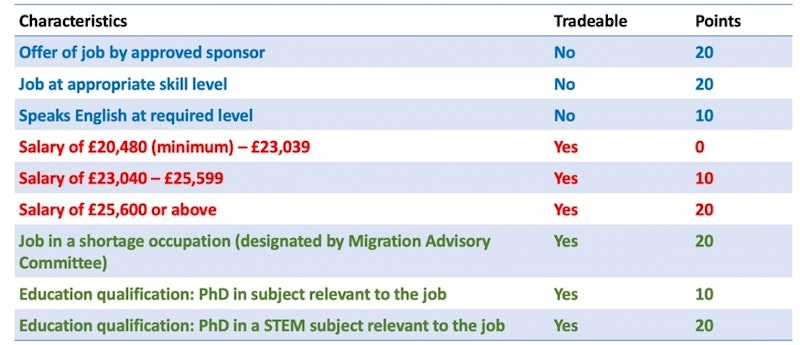Topic Videos
UK’s New Points-Based Immigration System
- Level:
- AS, A-Level, IB
- Board:
- AQA, Edexcel, OCR, IB, Eduqas, WJEC
Last updated 20 Feb 2020
In this video we look at reforms to the UK’s immigration system following our exit from the European Union

Net migration figures of the United Kingdom from 1980 to 2019 (in 1,000s)
First, some important context on the scale of emigration (outward movement) and immigration (inward movement) in the UK. As our chart shows, over the last forty years there has been a significant rise in both emigration and immigration. Net migration is the balance between the two figures, and it reached an annual peak of 343,000 in 2015, just a year before the EU referendum. Since then, net migration has declined dropping to 226,000 in 2019 according to the most recent data.
Net migration figures of the United Kingdom from 2008 to 2019 (in 1,000s), by citizenship
There has been a steep drop in net migration into the UK from other EU countries in the years since there referendum. Indeed the figure in 2019 (59,000) was lower than the level in 2008 (63,000) in the year of the Global Financial Crisis. This context is important. Net migration from the EU has been dropping for some time. Will it continue under the new points-based system favoured by the Home Office?

Key Basics on the New Immigration System
- New rules take effect from January 2021 after the transition period
- Free movement enshrined as members of the EU comes to an end
- Workers will need seventy (70) points to enter the UK
- All EU and non-EU citizens, will need to demonstrate they have a
- (i) job offer from an approved sponsor (employer)
- (ii) that the job offer is at the required skill level
- (iii) that they speak English
- Students will also be covered by the points-based system and they can stay on in the UK for two years following the completion of their full-time studies.
The 70 points threshold

Pressure from the Home Office on UK Employers
“UK businesses will need to adapt and adjust to the end of free movement, and we will not seek to recreate the outcomes from free movement within the points-based system. As such, it is important that employers move away from a reliance on the UK’s immigration system as an alternative to investment in staff retention, productivity, and wider investment in technology and automation.”
Which sectors are most likely to be affected?
- Hospitality (including hotels and restaurants)
- Social care (e.g. people working in care homes)
- Farming (e.g. fruit and vegetable picking)
- Food and drink manufacturers (e.g. meat processing)
- Construction (which relies heavily on self employed)
Importance of immigration reform to macroeconomic objectives
- Consider impact on short run aggregate supply (SRAS) if labour shortages cause wage rates to rise
- Risk of higher prices for consumer goods e.g. if farming is unable to find enough temporary workers to harvest crops. More food may have to be imported.
- Will migration controls stimulate significant extra investment in automation?
- Will firms operating in the UK be able to train and employ more of the economically inactive population?
- There is a global market for talented people. Will the UK continue to attract them if it is seen as hostile to free movement?
Priti Patel has claimed staff shortages under the government's new immigration system could be dealt with by training the 8.5 million who are economically inactive
— BBC Politics (@BBCPolitics) February 19, 2020
But @BBCRealityCheck finds that many of these people are students, carers, sick or retiredhttps://t.co/javCOOwob3
Allowing free movement of labour didn’t lead to British people up skilling themselves in a more competitive labour market. Firms didn’t spend on training to raise productivity with greater competition from imports. How likely is this to change with restricted immigration & trade?
— Richard Schofield (@SchoeyEconomics) February 19, 2020
You might also like
What are Supply-Side Policies?
Study Notes
Policies to Improve Labour Productivity
Study Notes
Aggregate Demand and Aggregate Supply
Topic Videos
Employment Rate (Labour Markets)
Study Notes

Outward Migration from India - Brain Drain or Brain Deposit?
8th November 2015

The Architecture of Choice
9th July 2016
Gender pay gap widest when people are in their fifties
14th October 2016
Daily Email Updates
Subscribe to our daily digest and get the day’s content delivered fresh to your inbox every morning at 7am.
Signup for emails